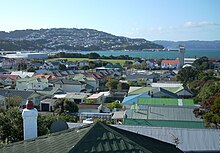Rongotai
| Rongotai | |
|---|---|

The north-west part of Rongotai.
|
|
| Basic information | |
| Local authority | Wellington City |
| Facilities | |
| Airport(s) | Wellington International Airport |
| Surrounds | |
| North | Evans Bay (bay) |
| Northeast | Maupuia |
| East | Miramar |
| Southeast | Moa Point |
| South | Lyall Bay (bay) |
| Southwest | Lyall Bay (suburb) |
| West | Kilbirnie |
| Northwest | Evans Bay (suburb) |
This article discusses the Wellington city suburb of Rongotai. For the article about the New Zealand parliamentary electorate of the same name see Rongotai (New Zealand electorate)
Rongotai is a suburb of Wellington, New Zealand, located southeast of the city centre. It is on the Rongotai isthmus, between the Miramar Peninsula and the suburbs of Kilbirnie and Lyall Bay. It is known mostly for being the location of the Wellington International Airport. It is roughly in the centre of the Rongotai electorate, which is much bigger than the suburb.
Until about the 15th century, the Rongotai isthmus was probably a shallow channel known as Te Awa a Tia. The only part of the current isthmus above water was the small hill which now has the airport control tower on it; the Miramar Peninsula was an island known as Te Motu Kairangi at the entrance to Wellington Harbour. Māori oral history describes a massive earthquake known as Haowhenua ("land swallower" or "land destroyer") which raised the seabed so that it became possible to wade across to Miramar. Studies of sediment suggest that it was once below sea level. Following the earthquake, the seabed seems to have silted up, creating a sandflat which linked Miramar to the mainland, at least at low tide. When James Cook entered Wellington Harbour in 1773 he found the former channel impassable by boat.
In 1855, another earthquake further lifted the isthmus so that it became permanently dry land. The southern half remained mostly sand dunes, but houses were built on the northern end, as was a coal-fired power station and Rongotai College. In 1939-1940 Rongotai became the site of the 1940 New Zealand Centennial Exhibition, which attracted more than 2.5 million people. The coal-fired power station was later closed and the site is now occupied by a fire station.
...
Wikipedia
